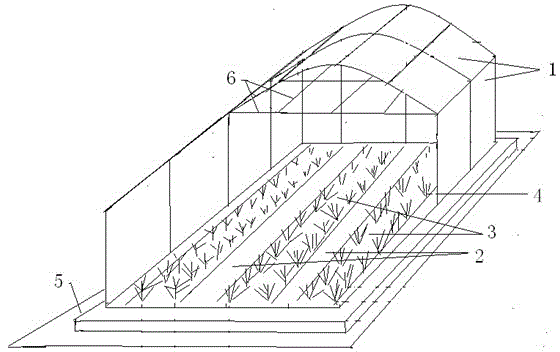Breeding method and device for young tussah
A technology of small silkworms and tussah silkworms, applied in the field of breeding methods and devices for small tussah silkworms, can solve the problems of affecting breeding performance, increasing the difficulty and cost of disease prevention, and increasing labor force, so as to reduce the loss of silkworm heads and improve the harvest of ants cocoon rate and increase the yield per unit area
- Summary
- Abstract
- Description
- Claims
- Application Information
AI Technical Summary
Problems solved by technology
Method used
Image
Examples
Embodiment Construction
[0019] Embodiment of the present invention: the breeding method of small tussah silkworms, set up a greenhouse, plant the ant-receiving saplings in the greenhouse, and the amount of eggs per kilogram needs to plant 150-200 ant-receiving saplings with a seedling age of 3 to 4 years. The distance between the seedlings is 0.3-0.4m to form an ant-receiving seedbed. The row spacing of the ant-receiving seedbed is 0.5m, and there is a passageway with a width of 1m between every two rows of ant-receiving seedlings; type, cutting at the main trunk 10cm away from the ground to promote the growth of side branches, leaving 5-6 side branches for each plant, and cutting the ant harvesting saplings with a flat top 50cm above the ground; within 3-5 days before silkworm rearing, the greenhouses in the greenhouse Sprinkle a layer of lime powder on the ground, then put the ants and sericulture equipment into the shed, disinfect with poison dissipator or chlorinated, and seal it for 1 day; open t...
PUM
| Property | Measurement | Unit |
|---|---|---|
| Line spacing | aaaaa | aaaaa |
Abstract
Description
Claims
Application Information
 Login to View More
Login to View More - R&D
- Intellectual Property
- Life Sciences
- Materials
- Tech Scout
- Unparalleled Data Quality
- Higher Quality Content
- 60% Fewer Hallucinations
Browse by: Latest US Patents, China's latest patents, Technical Efficacy Thesaurus, Application Domain, Technology Topic, Popular Technical Reports.
© 2025 PatSnap. All rights reserved.Legal|Privacy policy|Modern Slavery Act Transparency Statement|Sitemap|About US| Contact US: help@patsnap.com

